
Publisher:
Bonnie King
CONTACT:
Newsroom@Salem-news.com
Advertising:
Adsales@Salem-news.com

~Truth~
~Justice~
~Peace~
TJP
Jan-12-2011 16:34


 TweetFollow @OregonNews
TweetFollow @OregonNews
Tesla and the Exploration of Electromagnetism
By J. D. Adams Salem-News.comTesla ingeniously implemented the concept of the rotating AC (alternating current) field, which led to patents on motors and generators.
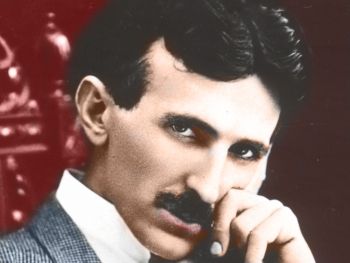 Photos courtesy: tesla.org, successfuloffice.com, geek-vs-life.com, twistedphysics.typepad.com, serbian-greeks.com, ovalecotech.ca |
(SALEM, Ore.) - In the last 200 years great strides were taken to understand the nature of electronics and its potential to transform the world. Chemists, mathematicians, and scholars were drawn toward the curious machinations of electromagnetism, often working in parallel, giving rise to disputes over patents and historical honor.
The exploration of electromagnetism had great practical impact with the imaginative and controversial work of Nikola Tesla. Although exceedingly brilliant, Tesla failed to protect his intellectual property and business interests, and many of his ideas today bear the trademark of others such as Westinghouse and Marconi.
The first attempts at defining electromagnetism begin with the work of the French physicist Andre-Marie Ampere, for whom the Ampere unit of electric current is named. He was inspired by an earlier electrical experiment conducted by Danish physicist Hans Christian Orsted. On September 18, 1820, Ampere submitted a paper on the nature of electromagnetism to the Paris Polytechnic Institute, where he was a professor of mathematics. Ampere’s thorough treatment of electromagnetism in this paper opened up the subject to the world at large.
It should be noted that legal scholar Gian Domenico Romagnosi published an obscure article on the relationship between electricity and magnetism in 1802. This was printed in an Italian newspaper but received little notice.
Concurrent with the revelations of Ampere, British scientist Michael Faraday began his now-famous work with electricity. His relentless and painstaking approach to experimentation produced remarkable results and was an inspiration to later researchers. Faraday invented the first successful electric motor, based on earlier failed attempts by Humphry Davy and William Hyde Wollaston.
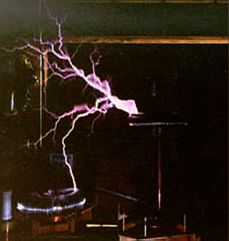
In 1831, he began experiments that yielded the historic visualization of lines of flux that surround magnets and current-carrying conductors. This revelation lead to the invention of the dynamo, a generalized machine capable of power generation or rotational torque. Another great step in the progression of technology was taken with the development of Faraday’s Law of Induction, which later became an integral part of Maxwell’s equations.
The pioneering research of early experimenters was collected and organized by Scottish physicist James Clerk Maxwell. His work is unique in its scope and relevance to the 20th century understanding of the universe. Maxwell derived a set of equations that define the interrelationship of electric and magnetic fields and the propagation of electromagnetic waves at the speed of light.
He proved the validity of these equations in experiments conducted between 1864 and 1873. These mathematical contributions greatly advanced the understanding of the spectrum of electromagnetic radiation, and are a foundation for Albert Einstein’s theory of relativity. Maxwell’s equations are notable as the first unification of laws governing the universe, a process that continues to this day with the sub-atomic, multi-dimensional world of string theory.
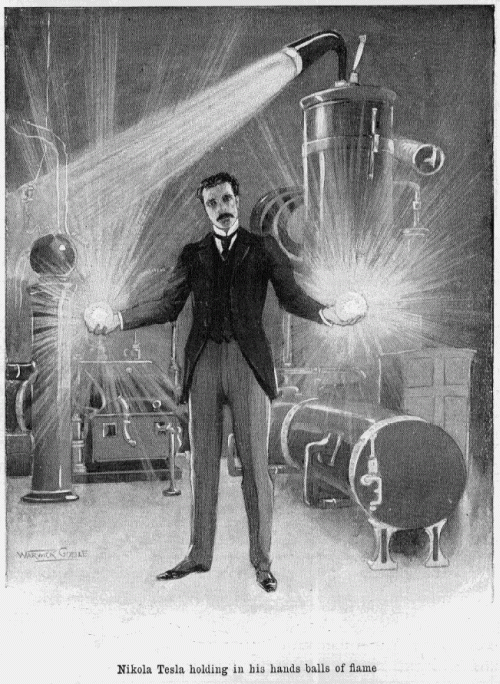
At this point in history, the groundwork for electromagnetic theory has been laid, but there is much to be accomplished. Arriving on the scene is a luminary inventor who is the centerpiece of this article. His fantastic achievements propelled the world into the future like a time machine, evoking stark disbelief in many to this day. Gather your imagination about you, set aside the trappings of the mundane, and enter the protean world of Nikola Tesla.
Tesla was born in Croatia, an area that was a part of the Austro-Hungarian Empire until 1918, later named Yugoslavia. He studied at the Austrian Polytechnic Institute, becoming the most brilliant electrical engineer of his time. Tesla immigrated to this country in 1884. Tesla’s ideas and patents stand behind the entire infrastructure of technology, as we know it today. Tesla dazzled the public with his showmanship, demonstrating his fantastic inventions for people from all over the world. At the peak of his career, Tesla hobnobbed with the rich and famous, and with these relationships he was able to obtain the financial backing he needed for research and development.
Tesla ingeniously implemented the concept of the rotating AC (alternating current) field, which led to patents on motors and generators. George Westinghouse purchased from Tesla the multiphase AC patents that are the foundation for the AC power distribution system that we use today. AC power can be easily stepped up in voltage with a transformer for efficient long distance transmission.
Tesla's power transmission system eclipsed the DC (direct current) system promoted by his rival and former employer Thomas Edison. The public became aware of AC power when Westinghouse and Tesla successfully underbid Edison for a contract to electrify the 1893 World’s Fair Exposition in Chicago with AC.
Tesla advanced the theory of AC with the completion of several novel devices. At St. Louis, Missouri in 1893, he demonstrated the use of radio communications years before Marconi, who is popularly attributed with the invention of radio. In fact, the Courts later ruled in favor of Tesla concerning the invention of radio. Radio communications were used when Tesla demonstrated the use of remote-controlled watercraft for the U.S. military.
The futuristic watercraft employed robotics and a form of logic-gate control circuitry. The military ignored the potential of his invention that today forms the cutting-edge of defense technology. Tesla also proposed to the military that timed pulses of radio-frequency energy could be used to track distant objects. The military declined to pursue the idea, which we know today as RADAR.
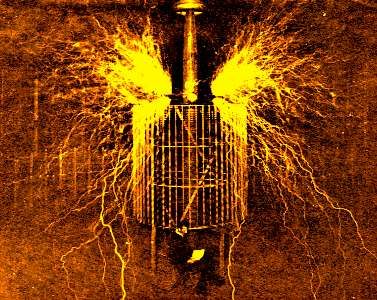
The military potential of Tesla’s ideas did not go entirely unnoticed. Later in life Tesla was invited to be a part of the Manhattan Project, the covert think-tank that developed the atomic bomb. However, he refused to be part of anything that was offensive and destructive in a wholesale fashion. Instead, Tesla had invented a form of particle accelerator weapon that focused energy into a small area. It was to be used as a deterrent, or defensive weapon for peacekeeping.
The U.S. government again showed little interest, but after Tesla's death the FBI raided his home in New York and confiscated his notes and papers. Most of these have mysteriously dropped out of sight, except for a few items that were returned to his home country to be displayed in the Tesla Museum in Belgrade, Yugoslavia. It's not unlikely that the focused beam technology that he developed formed the basis for the Strategic Defense Initiative that was started in the Reagan administration. Controversy rages today whether Tesla planted the seed for the so-called Scalar Technology with it's alleged remote destructive power.
Another controversial area of research for Tesla was the wireless transmission of power. He laid the groundwork for this with the invention of the Tesla high voltage transformer.
Tesla's idea was to use a tuned step-up transformer, resonant to the inductance and capacitance present in the circuit. A version of this is used in every television set to produce the high voltage necessary for the display. Taking the concept one step farther, he realized that the Earth itself had distinct electrical properties and a resonant frequency, which is approximately eight Hertz.
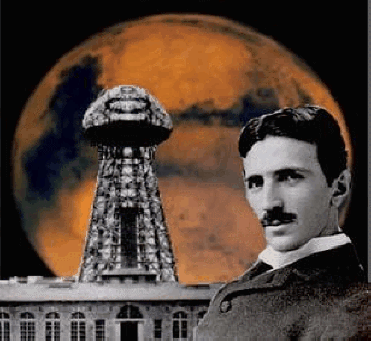
By using high voltage energy timed to the resonant frequency of the Earth, a phenomenon he termed resonant rise was achieved, in which an excitation signal can be used to resonate a larger source of power with a cumulative effect. A dramatic example of this principle in mechanical terms was the destruction of the Tacoma Narrows Bridge by the wind in 1940. To employ this concept, he built an enormous Tesla coil above his laboratory on the outskirts of Colorado Springs that he called a magnifying transmitter. With this he was able to generate lightning bolts a hundred and thirty feet long.
As people walked about in the town of Colorado Springs, the ground current he generated drew long sparks to people's shoes and to metallic objects. Out in the countryside, horses stampeded from the electrification of the ground. Miles away, the sound of thunder could be heard from the sky above his laboratory.
Tesla's work attracted the attention of wealthy financiers. One of them was J. P. Morgan, who later backed a laboratory on Long Island, New York, named Waldencliffe. Like Colorado Springs, this was built with a huge transformer and transmitting tower. However, Waldencliffe was never completely finished. Tesla had told the world that the tower was being built for the purpose of experimenting with communications.
While this was probably true, another use was for research into the global transmission of power. Tesla envisioned a utopian world where power could be transmitted either through the Earth or by means of the atmosphere. It would be a system of free power for the masses. When Morgan found out about this scheme, he pulled the financial plug on Tesla. It was a sad testimony to the power of greed.
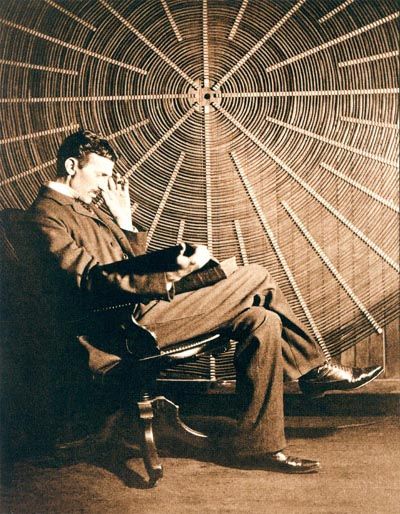
Tesla never recovered from this financial setback, but he still remained active in research for the rest of his life, obsessed with Einstein’s theory of relativity and the study of quantum physics. Out of this research came proposals concerning time travel and the manipulation of gravity. But unlike his younger years, this era of his life never produced tangible results that proceeded beyond the experimental stage.
To Tesla’s credit are over 700 patents. He contributed to diverse fields including avionics, quantum physics, seismology, medicine, and radio astronomy. Albert Einstein, Lord Kelvin, Edwin H. Armstrong, and many others have paid tribute to Tesla’s work in glowing terms, and he appeared on the cover of Time Magazine in 1931.
Tesla’s many lectures and demonstrations inspired and educated fellow scientists. His inventions form a foundation that others have built on, but to the public today he remains largely unknown. Nikola Tesla lived the last years of his life in relative isolation; his patents expired or sold, royalties and funding gone. He died a broken and destitute man in 1943, surrounded by a new world that he created. There are parallels between Tesla's life and the story of the Crucifixion, and other notables in history who set out to improve the plight of humankind, only to find themselves assailed by corrupt forces.
Consider for a moment the lives of Abraham Lincoln, John F. Kennedy, Martin Luther King, and John Lennon. How different a world it would be if we could be free from the shackles of energy as Tesla intended.
Parallel to Tesla’s spectacular work to explore the potentials of electromagnetism, research continued to perfect devices for amplification. In 1880 Thomas Edison noted the phenomenon of thermionic emission, known thereafter as the “Edison Effect”.
His experiments with incandescent light bulbs showed that electrons were driven off a heated filament. This produced a detectable current flow through the vacuum of a light bulb. Based on this principle, the British scientist John Ambrose Fleming in 1904 invented the first diode, a device that produces unidirectional current flow. His invention was essentially a light bulb with an extra electrode inside. When the electrode (known as the anode) is at a higher DC potential, electrons will flow from the heated filament to the anode. Because the filament is hot and the anode is cold, current will flow in one direction only. Like the solid-state diodes that are used today, Fleming’s diode found use in power supplies to rectify AC to DC.
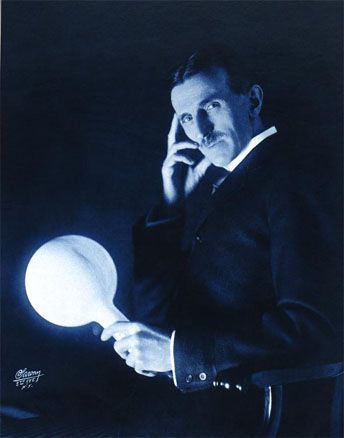
The stage was set for the invention of the first true amplifying device. American inventor Lee de Forest patented a vacuum tube in 1907 that contained a “grid” or third electrode. When a signal was applied to the grid, it modulated the current flow between the filament and the anode. The Audion, as it was called, allowed robust amplification of weak signals. It was a momentous point for the electronics industry. A plethora of specialized devices were derived from de Forest’s triode tube up until the 1960’s. The invention paved the way for significant progress in the development of circuits for audio, radio, and the computer.
Except for a few high-voltage, high-power applications in which tubes still prevail, solid-state devices have allowed elegant miniaturization of bulky tube equipment. The credit for the invention of the transistor in 1948 is given to the research team of Bardeen, Brattain, and Shockley at Bell Laboratories.
This was for the germanium point-contact transistor, a fragile device with inherent difficulties in production. Later Morgan Sparks at Bell Labs invented the junction transistor, the rugged, more familiar device that we know of today. However, the first-ever transistor was patented in 1929 by Julius Lillienfeld. This was a metal-oxide field-effect device, what we refer to today as a MOS transistor. At the time of this invention, the purity of the semiconductors was a problem, so it never caught on.
It wasn’t until 1958 that General Electric and Crystalonics could economically produce field-effect transistors. Complementary metal oxide semiconductors, or CMOS, are the predominant element in today’s state-of-the–art computer processors. In this technology, stacked pairs of P and N type silicon MOSFETS produce a high or low logic state without excessive power dissipation.
Many years before transistors, vacuum tubes, or relays were invented that could implement our modern concept of computation, the means to construct a computer was devised by a visionary mathematician. The first computer was conceived by Charles Babbage in 1837 and was called the Analytical Engine. Babbage was elected Lucasian Professor of Mathematics at Cambridge University in 1828. Isaac Newton and later, Stephen Hawking held the same Chair.
Babbage’s design was to have been a mechanical digital computer, but was never constructed. Had it been built, it would have worked similarly to modern computers, for over 160 years ago he had used identical concepts in the construction and programming, including the arithmetic logic unit, control transfer, registers, and memory. It is truly a credit to his genius that he was able to predict the logic model that we are currently using.
Much of the controversy in computer history stems from early calculator designs. Exactly where one draws the line depends on your definition of a computing machine; the Enigma and Colossus were actually decryption machines. By prevalent standards, the first digital computer was completed in 1942 at Iowa State University by Professor John Atanasoff and Clifford Berry, a graduate student.
It included the modern concepts of computing such as binary arithmetic, separate memory and computing functions, and parallel processing. The war effort prevented Atanasoff from obtaining a patent on the computer at the time. A court case in 1973 ruled that the Atanasoff-Berry computer, known as the ABC, was the first automatic digital computer.
Traditionally, the first computer has been attributed to the work of John William Mauchly and John Presper Eckert. During World War II, a computing machine was desired to solve ballistic trajectories for weapons. Mauchly and Eckert, of the University of Pennsylvania’s Moore School of Electrical Engineering, made a proposal to the U.S. Army in 1943.
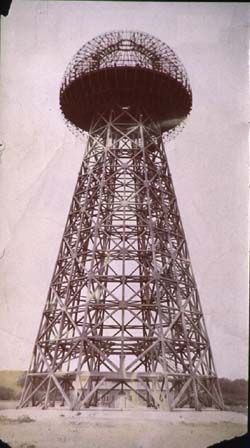 Real Photo of Tesla's Power Transmission |
As a secret military project known as PX, a working machine called ENIAC was built at the University of Pennsylvania, but was not completed until 1946. It contained over 18000 vacuum tubes. Mauchly and Eckert were able to obtain a patent for ENIAC in 1947 after some difficulty.
After the urgency of the war effort had passed, progress continued on computational hardware, such as magnetic disks and core memory. Computers for various government agencies become available after 1949. Rather ahead of its time was Simon, the first personal computer. It was a relay-based machine described by Edmund Berkeley in his book “Big Brains, or Machines That Think”, published in 1949. In Radio-Electronics issues in 1950 to 1951, he described the plans for building it. Berkeley Enterprises offered Simon for sale in 1950.
The culmination of all this electronic history, of the vacuum tube that evolved into the cathode-ray or picture tube, tuned resonant circuits, amplification and the generation of high voltage, even computer technology, it all comes together with television. The inventor of television was a precocious self-taught engineer named Philo T. Farnsworth. With an early interest in electronics, he conceived of the idea for the scanning of a television picture at the age of 14 while tilling back and forth in a potato field.
Philo persuaded his chemistry teacher, Justin Tolman, to tutor him, and he was accepted into Brigham Young University with only two years of high school. Years later, Philo credited Tolman for his success. During a patent case with RCA over the invention of television, Tolman testified to Philo’s genius and his early descriptions of his concepts for television. Farnsworth had to leave the university at the end of his second year, but he went on to produce a working television at the age of 21.
The invention of television is usually attributed to Vladimir Zworykin, a Russian-American inventor working for Westinghouse. Zworykin applied for a patent in 1923 but his design was not fully operational, so the patent was not issued until 1938. Farnsworth was able to demonstrate transmitted television signals in 1927 and was issued a patent in 1930. After transmitting the first image successfully, he replied anticlimactically, “There you are, electronic television”.
A long series of court battles over the invention of television ensued. After the end of World War II, Farnsworth’s patents expired, and RCA took control of the production of TV sets. A campaign by RCA promoted Zworykin and David Sarnoff as the fathers of television, and Farnsworth fell into a bout of depression and drinking. He suffered a nervous breakdown and submitted to shock therapy. In the end, Philo T. Farnsworth felt TV wasn’t worth watching, and he prohibited his children from watching it.
Sources:
_____________________________
“Nikola Tesla.” Wikipedia. Internet.
“Andre-Marie Ampere.” Wikipedia. Internet.
“Michael Faraday.” Wikipedia. Internet.
“James Clerk Maxwell.” Wikipedia. Internet.
Postman, Neil. “Philo Farnsworth.” The Time 100. Internet.
Portz, Stephen. “Inventor of Television.” Physlink. Internet.
“History of the Vacuum Tube.” MOSweb Online. Internet.
Bellis, Mary. “Inventors of the Modern Computer.” About. Internet.
Walker, John. “The Analytical Engine.” Fourmilab. Internet.
“The Transistor Era.” Luminet. Internet.
“The First Personal Computer.” Blinkenlights. Internet.
_______________________________________________________________________
 J. D. Adams was born in Salem, Oregon, a descendant of Oregon Trail pioneer William Lysander Adams. As a wilderness explorer, photographer, and writer, he sustains a kinship with the spirit of the Oregon country. JD inhabits Oregon's Silicon Forest as an electronics professional with degrees in Electronics Engineering Technology and Microelectronics.
J. D. Adams was born in Salem, Oregon, a descendant of Oregon Trail pioneer William Lysander Adams. As a wilderness explorer, photographer, and writer, he sustains a kinship with the spirit of the Oregon country. JD inhabits Oregon's Silicon Forest as an electronics professional with degrees in Electronics Engineering Technology and Microelectronics.
He maintains a Web presence with a signature presentation in genres including travel, history, and technology.
You can write to Jim Adams at this email address: j1mcm0s@earthlink.net
Also, visit Jim's Website: home.earthlink.net/~j1mcm0s/
Articles for January 11, 2011 | Articles for January 12, 2011 | Articles for January 13, 2011

Salem-News.com:
googlec507860f6901db00.html



Terms of Service | Privacy Policy
All comments and messages are approved by people and self promotional links or unacceptable comments are denied.
Anonymous December 20, 2011 2:32 pm (Pacific time)
This is about as complete a package on Tesla as you can get. I really am impressed, because this surmounts a large collection of information about Nikola Tesla and it's one place. Anyway, I learned a LOT that I did not know before, such as Project PX...that was really something. What I think is great is the fact that Tesla dealt with a lot of enemies and people trying to suppress his ideas, but his legacy is now coming full circle. People are even building their own free energy devices like the ones featured here http://www.squidoo.com/how-to-make-a-tesla-coil. In the long run hi struggles were a great gift to humanity.
JDA January 16, 2011 8:09 pm (Pacific time)
People send me stuff. Here's some cool Tesla info from Tallbloke's Talkshop thread on the electric universe:
http://www.glebedigital.co.uk/blog/?p=1309
http://www.glebedigital.co.uk/blog/?p=1258
http://www.glebedigital.co.uk/blog/?p=1299
Linked from http://tallbloke.wordpress.com/2011/01/08/electric-universe-open-thread/
Daniel January 13, 2011 6:17 pm (Pacific time)
JDA one can only wonder of his achievements if financing did not become an issue and he did not face such opposition from the powerful of the day . . It would be a vastly different and probably much cleaner and peaceful world !
JDA January 13, 2011 9:32 am (Pacific time)
Yes, there is so much to tell about Tesla. I condensed the JP Morgan incident to its essence, that he backed out of critical financing of the Wardencliffe project.
Daniel January 12, 2011 8:11 pm (Pacific time)
Also for those interested there are bronze monuments to Tesla in both Niagara Fall USA and N.F. Canada .
Daniel January 12, 2011 7:53 pm (Pacific time)
It is also interesting to point out in 1931 Tesla powered an electric Pierce Arrow automobile for eight days with wireless power . With speed up to 90 mph . Morgans greed robbed the world of this inventors greatest works !
Daniel January 12, 2011 7:30 pm (Pacific time)
An interesting article except you omitted the part where westinghouse cheated Tesla out of his 1 dollar per motor royalty . You also glossed over JP Morgans financing of Wardencliff only to pull the loans when Tesla was in Europe trying to raise money for the project . Morgan had the whole project torn down and destroyed . It was in competition with the ac power system he had already put millions into .
[Return to Top]©2025 Salem-News.com. All opinions expressed in this article are those of the author and do not necessarily reflect those of Salem-News.com.